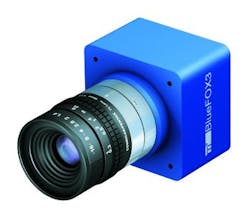MATRIX VISION adds USB 3.0 camera to portfolio
The mvBlueFOX USB camera family now features a USB 3.0-compliant camera. The USB 3.0 SuperSpeed mode offers a bit rate of 5000 Mbits/sec, and incorporating the USB 3.0 interface enables multicamera systems using bidirectional cables, as well as eliminating device polling. The mvBlueFOX product range features resolutions from VGA (600 frames/sec), to full HD (100 frames/sec), and up to 14 Mpixels (10 frames/sec). CMOS sensors from Aptina, CMOSIS, and e2v are integrated into the cameras, including three sensors with high near-infrared sensitivity suitable for hgih-speed or low-light applications. Integrated memory and a large field-programmable gate array (FPGA) support on-device image processing tasks.
MATRIX VISION
Oppenweiler, Germany
-- Posted by Vision Systems Design
View More Vision+Automation Products
Locate a vendor or system integrator in our Online Buyer's Guide
---
NEW PRODUCT PRESS RELEASE
USB3 Vision – New camera for the mvBlueFOX USB family
USB 3.0 potential successor for FireWire
At the Vision 2012 in Stuttgart, there will be no ignoring the USB3 Vision standard. The first release of the standard and the first products will be available at the same time. As an active member of the standard committee, MATRIX VISION will also introduce a USB 3.0 camera at the trade fair.
The camera will look like the successful, tiny CMOS camera family "mvBlueFOX-IGC". With more than 15 models, MATRIX VISION offers one of the widest product ranges with resolutions from VGA (600 fps), to full HD (100 fps), up to 14 Mpixels (10 fps). In addition to Aptina sensors, CMOS sensors from CMOSIS and e2v will be used, including 3 sensors with outstanding near-infrared sensitivity. These sensors are suitable for fast or low-light applications. Despite the compact size, the cameras feature integrated memory and a large FPGA with many smart features for image processing tasks.
These fast cameras with high resolutions are enabled by the USB 3.0 SuperSpeed mode, which offers a bit rate of 5000 Mbit/s and therefore can handle these data rates. Furthermore, the USB 3.0 standard is especially well suited for multiple camera solutions by using bidirectional cables and by eliminating device polling. Consequently, USB 3.0 is a perfect alternative to FireWire.
The number of proprietary USB 3.0 solutions is on the rise. However, proprietary solutions are struggling with acceptance. According to the AIA's 2010 market survey, it is notable that the market share of USB cameras is disproportionate to the high availability of the USB interface. In contrast, the GigE Vision interface and its cameras have the highest growth rates with no end in sight. For this reason, MATRIX VISION decided to support the USB3 Vision standard.
"Anyone looking for a USB 3.0 solution will love the advantages of the USB3 Vision standard," promises Horst Mattfeldt, MATRIX VISION's Director Standard Products. "Firstly, customers will benefit from the liberty to choose and combine hardware and software as soon as they support the USB3 Vision standard and secondly, they will no longer be tied to a manufacturer," continues Mattfeldt.
E-Mail: [email protected]
SOURCE: MATRIX VISION GmbH
